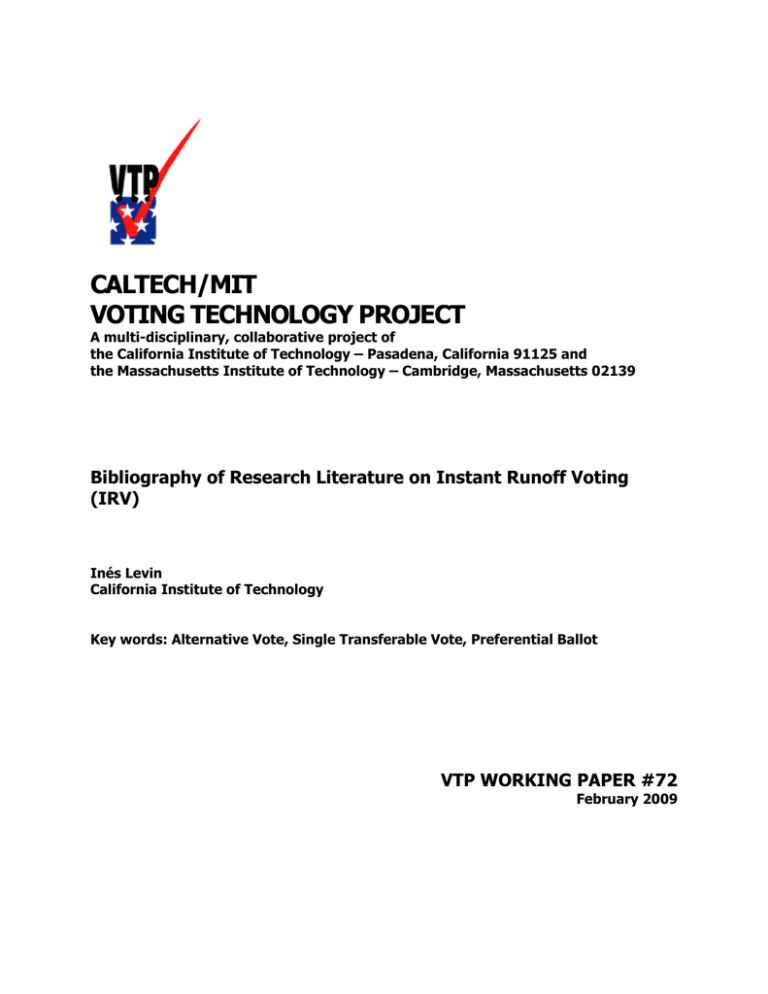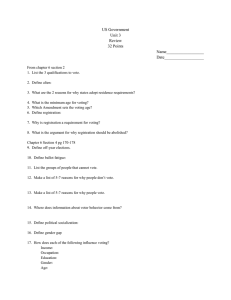CALTECH/MIT VOTING TECHNOLOGY PROJECT
advertisement

CALTECH/MIT VOTING TECHNOLOGY PROJECT A multi-disciplinary, collaborative project of the California Institute of Technology – Pasadena, California 91125 and the Massachusetts Institute of Technology – Cambridge, Massachusetts 02139 Bibliography of Research Literature on Instant Runoff Voting (IRV) Inés Levin California Institute of Technology Key words: Alternative Vote, Single Transferable Vote, Preferential Ballot VTP WORKING PAPER #72 February 2009 Bibliography of Academic Research Literature on Instant Runoff Voting (IRV) Inés Levin* California Institute of Technology February, 2009 Introduction This bibliography lists a diversity of publications related to Instant Runoff Voting (IRV). This voting method is a particular type of Single Transferable Vote (STV), applied in single-seat elections. † It is a sequential elimination voting procedure, and due to the use of ranked-ordered ballots, it belongs to the group of preferential-voting methods. It is also called Ranked Choice Voting (RCV) or Alternative Vote. One set of publications included in this bibliography is concerned with the impact of IRV, or runoff methods in general, on the party system, candidate behavior, voter choice, and minority representation. In particular, some authors compare the complexity of the system, and the incentives for strategic voter choice, and cooperation between candidates, relative to alternative methods. Another set of publications deals with the experience of several countries with the use of IRV –such as Australia, Fiji, and New Guinea, with some scholars focusing specifically on the encouragement of inter-ethnic cooperation and minority inclusion in divided societies, and on the moderation-character of policy outcomes. Finally, an additional group of publications considers the need for electoral reform in the US, and evaluates the adoption and results of the use of IRV in recent elections in the city of San Francisco. The selection criteria for inclusion in this bibliography was being a published book or peer reviewed article, making a significant contribution to the understanding of the voting system, by either studying its properties, its advantages and disadvantages relative to alternative methods, or providing evidence of its performance in real world situations. Academic Research Literature Bartholdi, J III and J.B. Orlin, 1991, “Single Transferable Vote Resists Strategic Voting”, Social Choice and Welfare, Volume 8(4): 341–354. Bean, C. 1986, “Electoral law, Electoral Behaviour and Electoral Outcomes: Australia and New Zealand compared”, Commonwealth & Comparative Politics, 24(1): 57–73. Bean, C., 1997, “Australia's Experience with the Alternative Vote”, Journal of Representative Democracy, 34(2): 103–110. Brams, S. J. and D. R. Herschbach, 2001, “Editorial: The Science of Elections”, Science, New Series, 292 (5521): 1449. Brams, S. J. and D. R. Herschbach, 2001, Response to R. Richie, T. Bouricius and P. Macklin, “Candidate Number 1: Instant Runoff Voting”, Science, New Series, 294(5541): 303–306. * Graduate student in social science, California Institute of Technology. † The Single Transferable Vote (S.T.V.) is also referred as “Hare” or “Clark” voting. Carey, J. M. and M. Soberg Shugart, 1995, “Incentives to Cultivate a Personal Vote: A Rank Ordering of Electoral Formulas”, Electoral studies, 14(4): 417–439. Cox, G. 1997, “Making Votes Count”, Cambridge University Press. Doron, G., 1979, “The Hare Voting System is Inconsistent”, Political Studies, 28(2): 283–286. Doron, G. and R. Kronick, 1977, “Single Transferrable Vote: An Example of a Perverse Social Choice Function”, American Journal of Political Science, 21(2): 303–311. Dummett, M. A. E., 1984, “Voting Procedures”, Oxford: Clarendon Press. Farrell, D. M. and I. McAllister, “1902 and the Origins of Preferential Electoral Systems in Australia”, Australian Journal of Politics and History, 51(2): 155–167. Fishburn, P. C., 1974, “Paradoxes of Voting”, The American Political Science Review, 68(2): 537-546. Fishburn, P. C., and S. J. Brams, 1983, “Paradoxes of Preferential Voting”, Mathematics Magazine, 56(4): 207-214. Fraenkel, J., 2004, “Electoral Engineering in Papua New Guinea: Lessons from Fiji and Elsewhere”, Pacific Economic Bulletin, 19(1): 122–32. Fraenkel, J., and B. Grofman, 2004, “A Neo-Downsian Model of the Alternative Vote as a Mechanism for Mitigating Ethnic Conflict in Plural Societies”, Public choice, 121(3): 487–506. Fraenkel, J., and B. Grofman, 2006, “Does the Alternative Vote Foster Moderation in Ethnically Divided Societies?: The Case of Fiji”, Comparative Political Studies, 39(5): 623–651. Fraenkel, J., and B. Grofman, 2007, “The Merits of Neo-Downsian Modeling of the Alternative Vote: A Reply to Horowitz”, Public Choice, 133 (1): 1-11. Grofman, B., 2008, “A Taxonomy of Runoff Methods”, Electoral Studies, 27(3): 395–399. Grofman, B., and S. L. Feld, 2004, “If you like the Alternative Vote (a.k.a. the Instant Runoff), then you ought to know about the Coombs Rule”, Electoral Studies, 23(4):641–659. Grofman, B. and M. S. Lewis-Beck, 2005, “Elections Under the French Double-Ballot System: An Introduction”, French Politics, 3(2): 93–97. Heitshusen, V., G. Young and G. D. M. Wood, 2005, “Electoral Context and MP Constituency Focus in Australia, Canada, Ireland, New Zealand, and the United Kingdom”, American Journal of Political Science, 49(1): 32–45. Hill, S., 2002, Fixing Elections: The Failure of America's Winner Take All Politics, New York: Routledge. Hill, S. and R. Richie, 2005, “Success for Instant Runoff Voting in San Francisco”, National Civic Review, 94(1): 65–68. Hoffman D. T., 1983, “Relative Efficiency of Voting Systems”, SIAM Journal on Applied Mathematics, 43(5): 1213–1219. Horowitz, D. L., 1990, “Comparing Democratic Systems”, Journal of Democracy, 1(4): 73-79. Horowitz, D. L., 2003, “Electoral Systems: A Primer for Decision Makers”, Journal of Democracy, 14(4): pages 115–127. Horowitz, D. L., 2004, “The alternative vote and interethnic moderation: A reply to Fraenkel and Grofman”, Public Choice, 121: 507–516. Horowitz, D. L., 2006, “Strategy Takes a Holiday: Fraenkel and Grofman on the Alternative Vote”, Comparative Political Studies, 39(5): 652–662. Horowitz, D. L., 2007, “Where have all the parties gone? Fraenkel and Grofman on the alternative vote – yet again”, Public Choice, 133: 13–23. Hughes, C. A., and B. D. Graham, 1968, “A handbook of Australian government and politics 1890-1964”, Canberra: Australian National University. Jaensch, D. 1983, “The Australian party system”, Sydney: Allen and Unwin. Jansen, H. J., 2004, “The Political Consequences of the Alternative Vote: Lessons from Western Canada”, Canadian Journal of Political Science, 37(3): 647–669. Jerdonek, C., 2006, “Bringing the Election to the Voters with Instant Runoff Voting”, National Civic Review, 95(4): 48–53. Karvonen, L., 2004, “Preferential Voting: Incidence and Effects”, International Political Science Review, 25(2): 203–226. Kumar, S., B Prasad , 2004, “Preferential voting and Political Engineering: The case of Fiji's 1999 and 2001 general elections”, Commonwealth & Comparative Politics, 42(3): 312–332. Levin, J., and B. Nalebuff, “An Introduction to Vote-Counting Schemes”, Journal of Economic Perspectives, 9(1): 3–26. Lijphart, A., 1990, “Electoral systems and party systems”, Oxford University Press. Lijphart, A., 1999, “Australian Democracy: Modifying Majoritarianism?”, Australian Journal of Political Science, 34(3): 313–326. Lijphart, A., 2004, “Constitutional Design for Divided Societies”, Journal of Democracy, 15(2): 96–109. Massicotte, L., 2001, “Alternative Voting or Mixed Member/Proportional: What Can We Expect?”, Policy Options, 22(6): 41–43. McGann, A. J., W. Koetzle, and B. Grofman, 2002, “How an Ideologically Concentrated Minority Can Trump a Dispersed Majority: Nonmedian Voter Results for Plurality, Run-off, and Sequential Elimination Elections”, American Journal of Political Science, 46(1): 134-147. Merrill, III, S., 1984, “A Comparison of Efficiency of Multicandidate Electoral Systems”, American Journal of Political Science, 28(1): 23–48. Myerson, R. B., 1993, “Incentives to Cultivate Favored Minorities Under Alternative Electoral Systems”, The American Political Science Review, 87(4): 856–869. Neely, F. and C. Cook, 2008, “Whose Votes Count? Undervotes, Overvotes, and Ranking in San Francisco’s Instant-Runoff Elections”, American Politics Research, 36(4): 530–554. Neimi, R. G., W. H. Riker, 1976, “The Choice of Voting Systems”, Scientific American, 234: 21–27. Norris, P., 1995, “The Politics of Electoral Reform in Britain”, International Political Science Review, 16(1): 65– 78. Olson, E. C., and S. Hill, 2002, “Big Wins for Democracy: San Francisco and Vermont Vote for Instant Runoff Voting”, National Civic Review, 91(2): 201–204. Ordeshook, P. C., and L. Zeng, 1994, “Some properties of Hare voting with strategic voters”, 78(1): 87–101. Rae, D. W., 1967, “The political consequences of electoral laws”, New Haven, Yale University Press, 1967. Rapoport, M., 2003, “Election Reform Arena Shifts to States”, National Civic Review, 92(3): 46–48. Reilly, B., 1997, “The alternative vote and ethnic accommodation: New evidence from Papua New Guinea”, Electoral studies, 16(1): 1–11. Reilly, B., 2001, “Evaluating the effect of the electoral system in post-coup Fiji”, Pacific Economic Bulletin, 16(1): 142–149. Reilly, B., 2002, “Electoral Systems for Divided Societies”, Journal of Democracy, 13(2): 156–170. Reilly, B., 2004, “The Global Spread of Preferential Voting: Australian Institutional Imperialism?”, Australian Journal of Political Science,. 39(2): 253–266. Reilly, B. and M. Maley, 2000, “The Single Transferable Vote and the Alternative Vote Compared”, In Elections in Australia, Ireland and Malta under the Single Transferable Vote: Reflections on an Embedded Institution, eds S. Bowler and B. Grofman. Ann Arbor: University of Michigan Press. Richie, R., 2004, “Instant Runoff Voting: What Mexico (and Others) Could Learn”, Election Law Journal, 3(3): 501–512. Richie, R., T. Bouricius and P. Macklin, “Candidate Number 1: Instant Runoff Voting”, Science, New Series, 294(5541): 303–306. Richie, R., C. Kleppner, T. Bouricius, 2000, “Instant Runoffs: A Cheaper, Fairer, Better Way to Conduct Elections”, National Civic Review, 89(1): 95–110. Riker, W. H., 1982, “The Two-Party System and Duverger's Law: An Essay on the History of Political Science”, The American Political Science Review, Volume 76(4): 753-766. Saari, D. G., 2003, “Unsettling aspects of voting theory”, Economic Theory, 22: 529–555. Sharman, C., A. M. Sayersb and N. Miragliotta, 2002, “Trading party preferences: the Australian experience of preferential voting”, Electoral studies, 21(4): 543–560. Tideman, N., 1995, “The Single Transferable Vote”, The Journal of Economic Perspectives, 9(1): 27–38. Woodall, D. R., 1997, “Monotonicity of single-seat preferential election rules”, Discrete Applied Mathematics, 77: 81–98. Wright, S. G., and W. H. Riker, 1989, “Plurality and runoff systems and numbers of candidates”, Public Choice, 60(2): 155–175.






